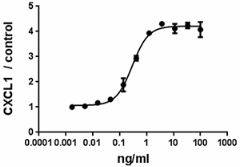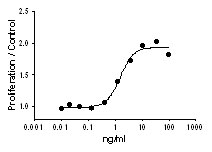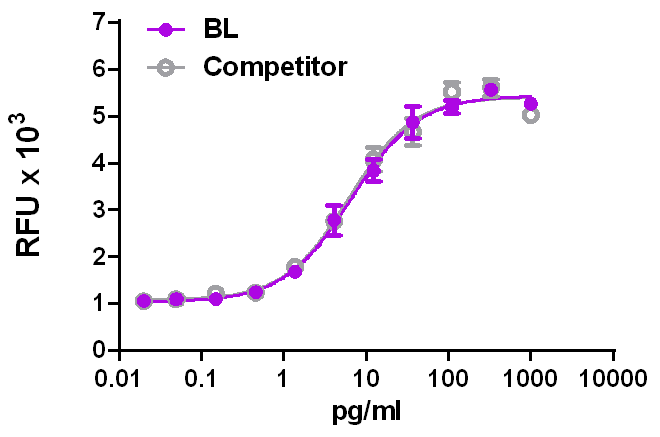- Regulatory Status
- RUO
- Other Names
- IL25, IL17E
- Ave. Rating
- Submit a Review
- Product Citations
- publications

-

Mouse IL-25 induces CXCL1/GRO alpha in HT-29 human colon adenocarcinoma cells.
IL-25 (also known as IL-17E) is a member of the IL-17 family, which includes IL-17A, IL-17B, IL-17C, IL-17F, and IL-17A/F. The primary sequence homology differs between family members, with mouse IL-17A and IL-17F having the highest homology (49%), while mouse IL-17A and IL-25 have the lowest (28%). IL-25 induces gene expression of IL-4, IL-5, and IL-13 in multiple tissues, and this induction results in T helper 2 (TH2)-type immune responses; this is characterized by an increase in serum IgE levels, pathologic changes in the lungs and digestive tract with eosinophilic infiltrates, an increase in mucus production, epithelial cell hyperplasia, and overall amplified allergic inflammation. IL-25 shares the receptor IL-17RB with IL-17B, although it binds with much higher affinity than IL-17B.
Product DetailsProduct Details
- Source
- Mouse IL-25, amino acids Val17-Ala169 (Accession# NM_080729) was expressed in insect cells.
- Molecular Mass
- The 153 amino acid recombinant protein has a predicted molecular mass of 17.6 kD. This protein exists as a disulfide-linked homodimer. The DTT-reduced protein migrates at approximately 20 kD by SDS-PAGE. The non-reduced protein migrates as a homodimer, at approximately 40 kD by SDS-PAGE.
- Purity
- >95%, as determined by Coomassie stained SDS-PAGE.
- Formulation
- 0.22 µm filtered protein solution is in 20 mM NaH2PO4 pH 6.0, 0.5 M NaCl.
- Endotoxin Level
- Less than 0.01 ng per µg cytokine as determined by the LAL method.
- Concentration
- 10 and 25 µg sizes are bottled at 100 µg/mL. 100 µg size and larger sizes are lot-specific and bottled at the concentration indicated on the vial. To obtain lot-specific concentration and expiration, please enter the lot number in our Certificate of Analysis online tool.
- Storage & Handling
- Unopened vial can be stored between 2°C and 8°C for up to 2 weeks, at -20°C for up to six months, or at -70°C or colder until the expiration date. For maximum results, quick spin vial prior to opening. The protein can be aliquoted and stored at -20°C or colder. Stock solutions can also be prepared at 50 - 100 µg/mL in appropriate sterile buffer, carrier protein such as 0.2 - 1% BSA or HSA can be added when preparing the stock solution. Aliquots can be stored between 2°C and 8°C for up to one week and stored at -20°C or colder for up to 3 months. Avoid repeated freeze/thaw cycles.
- Activity
- Mouse IL-25 induces CXCL1/GRO alpha in HT-29 human colon adenocarcinoma cells. The ED50 = 0.15 - 1.0 ng/ml.
- Application
-
Bioassay
- Application Notes
-
BioLegend carrier-free recombinant proteins provided in liquid format are shipped on blue-ice. Our comparison testing data indicates that when handled and stored as recommended, the liquid format has equal or better stability and shelf-life compared to commercially available lyophilized proteins after reconstitution. Our liquid proteins are verified in-house to maintain activity after shipping on blue ice and are backed by our 100% satisfaction guarantee. If you have any concerns, contact us at tech@biolegend.com.
- Product Citations
-
Antigen Details
- Structure
- Heterodimer
- Distribution
-
IL-25 is produced by mast cells, epithelial cells, alveolar macrophages, microglia, and Th2 cells.
- Function
- IL-25 directly promotes Th2 cell differentiation and the expression of IL-4, IL-5, IL-13, CCL11 (eotaxin), and therefore, lung eosinophilia. IL-25 enhances IL-9 production by differentiated Th9 cells.
- Interaction
- CD4+ NKT cells, macrophages, endothelial cells, eosinophils, and Th2 and Th9 cells.
- Ligand/Receptor
- IL-25 binds to IL-17RB.
- Biology Area
- Apoptosis/Tumor Suppressors/Cell Death, Cell Biology, Immunology, Innate Immunity, Signal Transduction
- Molecular Family
- Cytokines/Chemokines
- Antigen References
-
1. Hurst SD, et al. 2002. J. Immunol. 169:443.
2. Ikeda K, et al. 2003. Blood 101:3594.
3. Kang CM, et al. 2005. Am. J. Respir. Cell. Mol. Biol. 33:290.
4. Kleinschek ME, et al. 2007. J. Exp. Med. 204:161.
5. Terashima A, et al. 2008. J. Exp. Med. 205:2727.
6. Angkasekwinai P, et al. 2010. Nat. Immunol. 11:250. - Gene ID
- 140806 View all products for this Gene ID
- UniProt
- View information about IL-25 on UniProt.org
Related FAQs
- Why choose BioLegend recombinant proteins?
-
• Each lot of product is quality-tested for bioactivity as indicated on the data sheet.
• Greater than 95% Purity or higher, tested on every lot of product.
• 100% Satisfaction Guarantee for quality performance, stability, and consistency.
• Ready-to-use liquid format saves time and reduces challenges associated with reconstitution.
• Bulk and customization available. Contact us.
• Learn more about our Recombinant Proteins. - How does the activity of your recombinant proteins compare to competitors?
-
We quality control each and every lot of recombinant protein. Not only do we check its bioactivity, but we also compare it against other commercially available recombinant proteins. We make sure each recombinant protein’s activity is at least as good as or better than the competition’s. In order to provide you with the best possible product, we ensure that our testing process is rigorous and thorough. If you’re curious and eager to make the switch to BioLegend recombinants, contact your sales representative today!
- What is the specific activity or ED50 of my recombinant protein?
-
The specific activity range of the protein is indicated on the product datasheets. Because the exact activity values on a per unit basis can largely fluctuate depending on a number of factors, including the nature of the assay, cell density, age of cells/passage number, culture media used, and end user technique, the specific activity is best defined as a range and we guarantee the specific activity of all our lots will be within the range indicated on the datasheet. Please note this only applies to recombinants labeled for use in bioassays. ELISA standard recombinant proteins are not recommended for bioassay usage as they are not tested for these applications.
- Have your recombinants been tested for stability?
-
Our testing shows that the recombinant proteins are able to withstand room temperature for a week without losing activity. In addition the recombinant proteins were also found to withstand four cycles of freeze and thaw without losing activity.
- Does specific activity of a recombinant protein vary between lots?
-
Specific activity will vary for each lot and for the type of experiment that is done to validate it, but all passed lots will have activity within the established ED50 range for the product and we guarantee that our products will have lot-to-lot consistency. Please conduct an experiment-specific validation to find the optimal ED50 for your system.
- How do you convert activity as an ED50 in ng/ml to a specific activity in Units/mg?
-
Use formula Specific activity (Units/mg) = 10^6/ ED50 (ng/mL)
 Login / Register
Login / Register 














Follow Us